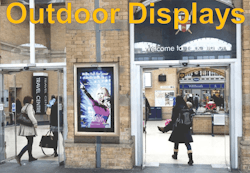Transit agencies looking to get into or expand its outdoor digital signage may want to start investing now.
Ralph Idems, of Toronto-based Vertigo Digital Displays, said some major rollouts are on their way later this year that will unveil some very exciting new products for the market in 2014.
“The successful rollouts show us this is a proven business model,” he said. “Ten years ago, they didn’t have indoor in rolled out successfully, so they weren’t going to venture into high risk outdoor.”
During a webinar hosted by Digital Media in Communications (DMIC), Idems said major advancements have been made in the past 24 months to drastically cut the cost of outdoor digital displays and make the return on investment much more attractive for investors.
Triple menu boards costing $65,000 each two years ago are now $12,000 each, and 72-inch LCD displays that used to retail at $60,000 to $70,000 are now $22,000 to $25,000 each. While the LED of the signage should be replaced every five years, the sign enclosure can last 25 years, so with an income of $1,500 per month, a return on investment time on signage can be reached in about eight months.
Idems said the transportation industry remains the biggest customers by far in outdoor digital signage.
Technology advancements have also made outdoor signage a good opportunity for potential investors, because technology has made the signs readable in all weather conditions and more durable while using less power. Idems said 72-inch displays are now being run on 15 amp circuits while just a few years ago they were ran on 60 amp circuits.
“It has been a trend among major clients for lower power because of the costs and it’s just good corporate policy,” he said. “It makes no sense to have a beacon on every street corner. That’s inefficient.”
Although energy efficiency and price decreases have made it more attractive for companies and transit agencies to explore digital signage options, Idems cautioned there are still safety issues that need to be explored before signs are installed. In many areas dynamic digital signage can’t be installed facing traffic, while in many cases there are rules dictating where dynamic signage can be placed near stairs to subway stations. It’s not allow in many areas to put dynamic digital signage facing people walking down subway stairs, but it’s not illegal to put dynamic signage to those approaching stairs.
Location for outdoor signage must be determined by security, installation and operations before putting signage up, because it can determine if a sign will be successful and ensure safety of those who engage it.
“If you miss one of these, you’re going to run into trouble,” Idems said.
But Idems said dynamic outdoor digital signage is becoming more interactive with users by allowing for people to download maps or train and bus schedules to their phones using near field communication at the signs or to purchase items on the spot. Some have tried to use gesture displays instead of touch displays, but Idems said too many issues have arisen to make it more prevalent at this time.
Bruno Pupo, senior national sales manager for LG Canada, said the cost effectiveness of the signs means tremendous growth with outdoor digital signage, however, some people who may want to purchase signage may be hesitant given how quickly the technology is advancing. He said advancements are no reason to hold off on buying outdoor digital signage, comparing it to how buying a computer and how quickly the technology advances.
“The reality is that you can pay the money and help your business today and help it in an extremely positive way,” he said.
About the Author
Joe Petrie
Associate Editor
I came to Mass Transit in 2013 after spending seven years on the daily newsbeat in southeastern Wisconsin.
Based in Milwaukee, I worked as a daily newspaper reporter with the Waukesha Freeman from 2006-2011, where I covered education, county and state government. I went on to cover courts for Patch.com, where I was the main courts reporter in the Metro Milwaukee cluster of websites.
I’ve won multiple awards during the course of my career and have covered some of the biggest political events in the past decade and have appeared on national programs.
Having covered local government and social issues, I discovered the importance of transit and the impact it can have on communities when implemented, supported and funded.

